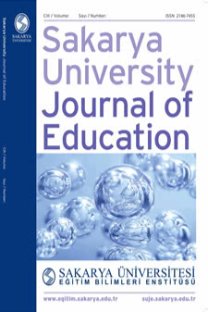Τhe Turkish Nominal Syntagmatic Sets 'Ad tamlaması': A Linguistic Approach in Turkish Second Language Acquisition and Teaching
Τhe Turkish Nominal Syntagmatic Sets 'Ad tamlaması': A Linguistic Approach in Turkish Second Language Acquisition and Teaching
Turkish as a second language, Turkish SLA, Turkish possessıves, Turkish compounds Ad tamlaması,
___
- References Aslan, E., & Altan, A. (2006). The Role of -(s)I in Turkish Indefinite Noun Compounds. Dil Dergisi, 131, 57-76.
- Bağrıaçık, M., & Ralli, A. (2013). Bare N(ominal) N(ominal) concatenations in Turkish: Compounds or syntactic fallacies? Στο N. Hathout, F. Montermini, & J. Tseng (ed.), Morphology in Toulouse. Selected proceedings of Décembrettes 7,Toulouse,2–3 December 2010 (p. 35-56). Munich: Lincom Academic Publishers.
- Bağrıaçık, M., & Andreou, M. (2011). Lexical categories and bare nominal concatenations in Turkish. 2nd Patras International Conference of Graduate Students in Linguistics, Proceedings (σσ. 33-46). Patras, Greece: University of Patras Publications.
- Bağrıaçık, M., & Ralli, A. (2015). NN-sI concatenations in Turkish: construct state nominals and phrasal compounds. In MIT Working Papers in Linguistics (p. 13-24). Cambridge, MA: MIT Press. Presented at the 8th Workshop on Altaic Formal Linguistics (WAFL8-2012).
- Dede, M. A. (1978). A syntactic and semantic analysis of Turkish nominal compounds. PhD Dissertation. University of Michigan.
- Dafnopatidis, V., & Sanlioglu, H. (2011). Τουρκική γραμματική στα ελληνικά [Turkish Grammar in Greek]. Athens:Perugia.
- Göksel, A., & Kerlslake, C. (2005). Turkish: A comprehensive grammar. Routledge: Taylor & Francis Ltd.
- Hankamer, J. (2008). Ad-phrasal affixes and suspended affixation. Chicago, IL: Paper presented at the SLA Annual Meeting.
- Ketrez, F. N. (2018). Acquisition of an agglutinating language under adverse neonatal conditions. Στο A. Bar-On, & D. Ravid (Εds.), Handbook of Communication Disorders: Theoretical, Empirical and Applied Linguistic Perspectives. Handbooks of Applied Linguistics 15. Mouton De Gruyter.
- Kharytonava, O. (2011). Noms composés en tyrc et le morphème -(s)I. PhD Dissertation. Ontario: University of Western Ontario.
- Kırkıcı, B. (2009). İmparator Çizelgesi vs. İmparatorlar Çizelgesi: On the (Non)-Use of Plural Non-Head Nouns in Turkish Nominal Compounding. Dilbilim Araştırmaları Dergisi, (1), 35-53.
- Kunduracı, A. (2013). Turkish Noun-Noun Compounds: A Process-Based Paradigmatic Account. PhD Dissertation. Calgary University.
- Lewis, G. L. (2000 (1967)). Turkish Grammar (2nd ed.). Oxford: Oxford University Press.
- Özer, S. (2010). Morphological Priming in Turkish Nominal Compound Processing. MA Thesis. Middle East Technical University.
- Tat, D. (2013). Word Syntax of Nominal Compounds: Internal and Aphasiological Evidence from Turkish. PhD Dissertation. Arizona: University of Arizona.
- Uzun, E. (ed.)(2011). Yeni Hitit 1 Yabancılar İçin Türkçe Ders Kitabı. Ankara:Ankara Üniversitesi Basımevi.
- Yılmaz, M. Y. (ed.) (2020). Yeni İstanbul. A1 Uluslararası Öğrenciler İçin Türkçe Ders Kitabı. İstanbul: Kültür Sanat Basımevi.
- Zegkinis, Ε., & Hidiroglu, P. (1995). Τουρκική γραμματική [Turkish Grammar]. Thessaloniki: Vanias.
- ISSN: 2146-7455
- Yayın Aralığı: 3
- Başlangıç: 2011
- Yayıncı: Sakarya Üniversitesi Eğitim Bilimleri Enstitüsü
The Impact of Literature Circles Technique in Speaking Skills
Safiye BÖLÜKBAŞI, Selim TİRYAKİOL
Huzeyfe BİLGE, İbrahim Doğukan DEMİREL
A Study On Developing Fluency And Accuracy Skills In Teaching Turkish As A Second Language
Bilal Ferhat KARADAĞ, Merve ERCAN
An Overview of Turkish Teaching in the Context of Language Policies
